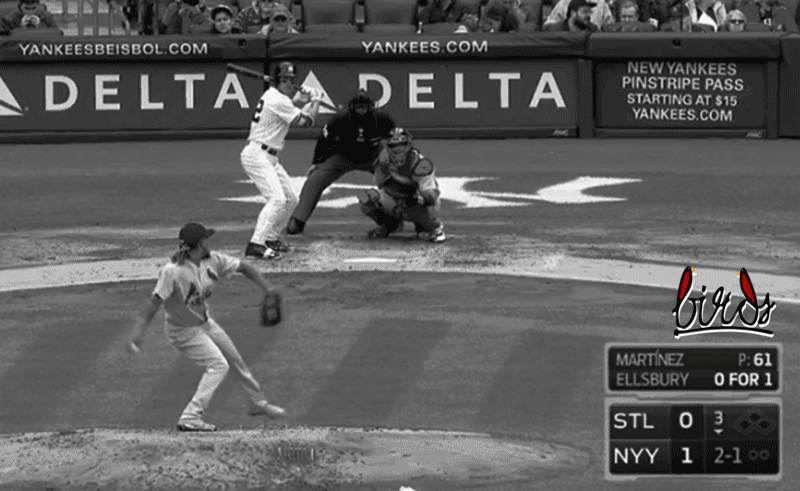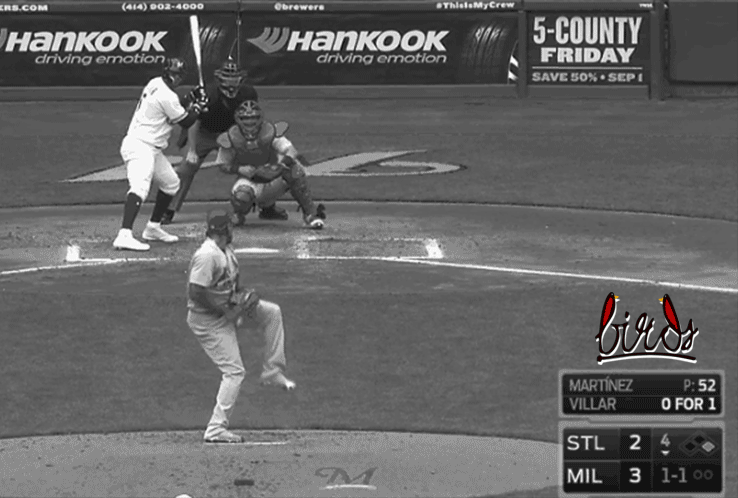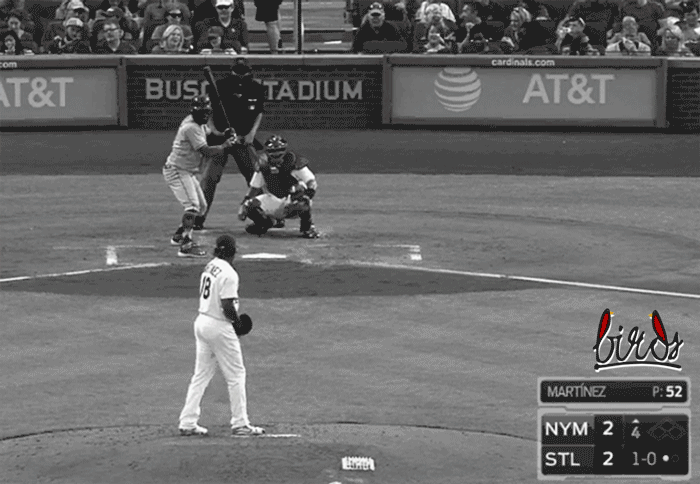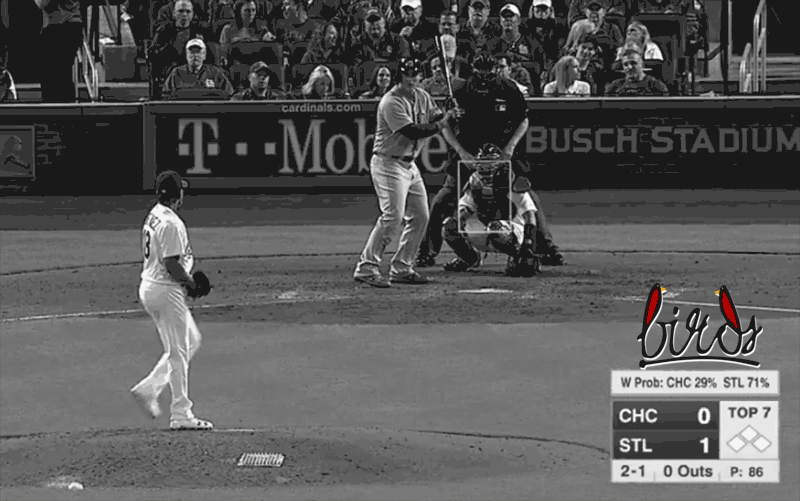
For the third consecutive season as a full-time starting pitcher, Carlos Martinez provided the St. Louis Cardinals with more than three wins above replacement (according to FanGraphs). His 10.1 fWAR since the beginning of the 2015 season ranks 21st highest among MLB starting pitchers. While I don't intend to deprecate the inherent value of the 21st-highest starting pitcher fWAR since 2015, Martinez's periodic flashing of brilliance and his electric repertoire leave us -- the fans and the organization -- wanting even more.
Just as you'd expect, the right-handed throwing Martinez is downright dominant versus right-handed hitters. In fact, only five starters have been better than Martinez versus righties (using wOBA) since 2015: Max Scherzer (three Cy Young Awards), Clayton Kershaw (three Cy Young Awards), Corey Kluber (two Cy Young Awards), Jake Arrieta (one Cy Young), and Kyle Hendricks (one Cy Young Award nominee). Frankly, it's nearly impossible to find a more qualified list of current MLB starting pitchers.
Thus, considering how effective Martinez already has been against righties, it's not realistic (or fair, for that matter) to expect him to evolve into being even better. Now, while he certainly can -- especially considering that, at 26, he is just now entering his "prime" -- the more reasonable approach would be to improve against lefties. And Martinez's struggles versus lefties are well documented nationally.
Career splits (via FanGraphs)

As you can see, the statistics back up the notion that Martinez has "one issue left," (given the author, the pun was intended, I'm certain). There exists quite a disparity in Martinez's performance based on batter handedness. And though he improved slightly versus lefties in 2016 (.322 wOBA), he took a step backwards in 2017 (.337 wOBA). Complaining about a .337 wOBA when the 2017 MLB average for right-handed starters versus lefties was .336 may come across as unfair, but remember, we are talking about the unofficial staff ace here.
Before a problem can be solved, the magnitude of the issue at hand must first be diagnosed. Martinez, historically, has struggled versus lefties. Okay, great, what exactly does that mean going forward? "Get better versus lefties" is the obvious solution, but how can Martinez arrive at this endpoint. Essentially what is he doing versus righties (very successful) that he isn't doing versus lefties (league average performance)? Or, considering batter handedness requires different approaches, what are other righty starters doing in order to have success versus lefties?
Let's start this journey by taking a look at Martinez's individual pitch results from 2017 when facing left-handed hitters:
2017 results vs. lefties (via BrooksBaseball.net)

One pitch stands out in particular: the sinker. Lefties experienced great success against the pitch in 2017. This comes one season after my admittedly elementary Viva El Birdos post in which I pleaded with Martinez to throw more sinkers. While Martinez did indeed throw more sinkers difference was barely noticeable (23.31% versus 21.75% in 2015-16). Honestly, with the results presented above, who can blame Martinez for not going all in on the "throw more sinkers versus lefties" approach.
That being said, I haven't given up on the "sinkers versus lefties" approach, and neither should Martinez, with a few tweaks of course. As shown in the table, both the changeup and slider remained solid weapons for Martinez last season (though the changeup was hit for a bit more power than usual). Given their respective velocities, their movement profiles, and what hitters see on their flights to the plate, the changeup and slider do not tunnel or sequence particularly well. Thus, a third pitch -- with a different velocity but similar movement profile (the sinker, in this case) -- must still be available to help set up these two offspeed options.
Here is where the problem solving (read: fun) begins. While Martinez experienced a career high in strikeouts (217) last season, he remains a prolific ground-ball inducer. The sinker is the biggest reason why, as it has induced ground balls on 65.19% of balls put in play. Thus, he will continue to throw the sinker versus batters of both hands, regardless of the results he experienced last season.
In 2017, using BrooksBaseball.net's heat maps, Martinez threw his sinker inside to lefties 14.81% of the time. While this appears to be a low percentage, how can we know for sure without comparing Martinez's rate to other sinker-throwing right-handed starting pitchers? And let me be clear, I don't want to compare Martinez's inside-sinker rate to the league average right-handed starting pitcher. Instead, I want to compare it to the inside-sinker rate of righties who have also experienced documented success versus lefties.
Using FanGraphs splits leaderboards tool (this new feature is amazing, by the way), the following righties have all experienced success versus lefties, especially when compared to Martinez (career .333 wOBA): Corey Kluber (.251 wOBA in 2017), Luis Castillo (.267 wOBA in 2017), Kyle Hendricks (.272 wOBA in 2016), and Charlie Morton (.249 wOBA in 2017). I chose these four because -- well, first and foremost, they were on the leaderboard -- but secondly, each utilizes a sinker fairly regularly. Upon further review, again using BrooksBaseball.net, all four locate their sinkers inside more frequently than Martinez did last season. While the inside-sinker rate by these pitchers varied widely -- from a high of 36.71% by Kluber to a low of 19.47% by Morton -- each rate eclipsed that of Martinez.
And it makes sense that right-handed starting pitchers successful versus lefties are locating their sinker inside more frequently. According to a quick Statcast search on BaseballSavant.com, in 2017, left-handed hitters posted an xwOBA of .373 on right-handed sinkers outside (but still in the strike zone) as compared to .308 on right-handed sinkers inside (but again, still in the strike zone). This is in line with the exit velocity heat map as well -- higher exit velocities away than inside, particularly in the zone.

As you'd expect, I called upon the great @cardinalsgifs to provide us all with some visuals to go along with my analysis:
Bad sinker location
Single by Jacoby Ellsbury (BrooksBaseball At Bat)

Single by Jonathan Villar (BrooksBaseball At Bat)

While both of these hits may have been relatively harmless singles, their respective exit velocities -- 106.3 MPH and 107.7 MPH -- should serve as a warning sign that they could have been considerably more damaging. If the launch angle had been optimized, these could have easily as doubles, maybe more. Martinez would be especially susceptible had he left either one of these two sinkers up, even slightly.
Double by Jose Reyes (BrooksBaseball At Bat)

Horizontally, this 95 MPH sinker was located almost perfectly, but because Martinez left it up in the zone, Reyes had no trouble launching it into the gap for a double. Reyes isn't as good of a hitter as he once was, but when he has the time to track a pitch longer and extend his arms
Double by Seth Smith (BrooksBaseball At Bat)

This 95.2 MPH sinker to Smith was located in an almost identical spot to the sinker thrown to Reyes. At 95.2 MPH with 10 inches of raw horizontal movement, Martinez should be able to have success with this pitch. However, as was the case against Reyes, Smith had plenty of time to track this pitch, get a feel for its location, and drive it the other way. I understand Martinez's frustration (check out his reaction after the ball was put in play), but I also know that he can benefit by taking this pitch inside, as already explained above and visualized below.
Good sinker location
Called strike to Ian Happ (BrooksBaseball At Bat)

The ole front-door sinker. It served as Chris Carpenter's money pitch, and as shown by Kluber's inside-sinker rate, it appears to be one of his go-to pitches as well. The common belief is that left-handed hitters feasts on pitches down and in as that is a natural sweet spot in their respective swing paths. This very well may be the case, but the notion usually applies to straight pitches or at least pitches breaking into a lefty.
This just isn't the case with sinkers. Out of the hand, sinkers appear as though they are heading for the hitters front knee only to tail back into the strike zone after the hitter already gave up on the pitch. Sure, if a hitter is looking for this pitch, there are better zones to attack (i.e. up or even further in), but given Martinez's complex repertoire, it isn't easy to guess what is going to be thrown next.
Called strike to Anthony Rizzo (BrooksBaseball At Bat)

Similar to the called strike to Happ, Rizzo is absolutely locked up by this 95.1 MPH front-door sinker. And what do you know? 95+ MPH with roughly 10 inches of horizontal movement leading to success, against a significantly better hitter (than Smith and Reyes) in Rizzo.
Remember the issues Martinez experienced when elevating the sinker on the outside corner? He actually experiences more success when elevating on the inside corner, and for those worried about sample size, this was a league-wide result last season.
Called strike to Ian Happ (BrooksBaseball At Bat)

With the bases juiced and a 1-0 count, Martinez wouldn't dare come inside to Happ, would he? You better believe it he would, and it worked out perfectly. Given its location wasn't really on the corner, it's not exactly a true front-door sinker, but after going up and away with a 98.7 MPH fourseamer for ball one, the same purpose -- locking up a good left-handed hitter -- was served.
Ground out by Yangervis Solarte (BrooksBaseball At Bat)

Admittedly, this sinker ended up nowhere near Molina's target. And it must be noted that up and in is probably the hardest location to pinpoint with a sinker versus lefties. However, when executed, you'll frequently a very similar result -- a harmless ground ball (exit velocity, 64.2 MPH) to the right side of the infield.
Bottom line
So did we definitely solve Carlos Martinez's struggles versus left-handed hitters? Not entirely. If it was that easy, I'd have a job in Major League Baseball. That being said, this is a small step in the right direction for Martinez. Command, as I believe, Eno Sarris puts it, is throwing pitches in tough-to-hit locations. Right now, Martinez just isn't doing that with his sinker versus lefties. Remember, success should be there for a 95+ MPH pitch with 10+ inches of horizontal movement. If Martinez begins to bring the pitch inside (and even up) more frequently, he should be primed for the next level as a starting pitcher.
As always, credit to @cardinalsgifs, BrooksBaseball.net, FanGraphs.com, and BaseballSavant.com for their contributions to this post.


Thank you for the comments, Ben and Aaron. I will address both of your comments in my video article I plan on recording tonight. It'll hopefully be published Friday.
I noticed that Carlos's best two pitches against lefties were his four seamer and slider. I don't know enough about this, so I'm truly asking - Is there anyway Carlos could embrace more of a curveball revolution approach - in other words, really turn up the amount of and aggressiveness with which he uses his slider against lefties, in all counts, with elevated four seamers and some inside sinkers in a supporting role? Or is that just now how pitching works. Also, I'd be curious to know if there are other RH pitchers who have success prioritizing a breaking pitch against lefties.
Joe - you might also look at how he compares to others his age. Of pitchers under 26 years old for 2015-2017 that have 450+ innings (I tried 550+ first and there were only he and Teheran - and 500+ was Cole, Martinez, Bauer, and Teheran only)...he's ranked 2nd in fWAR out of 9 guys. Gerrit Cole is the only one above him, by 1 fWAR. Martinez beats Cole in both ERA and xFIP and has pitched nearly 60 more innings.